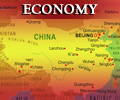China Economy Grows 4.9% as Rest of World Struggles With Coronavirus

Chinese officials said Monday that gross domestic product expanded by 4.9% in the third quarter from a year earlier, putting China’s economy back toward its pre-coronavirus trajectory half a year after the pandemic gutted its economy.
The 4.9% growth figure for the third quarter fell short of expectations but brings China’s trajectory closer in line with forecasts made at the beginning of the year for 2020 growth of between 5.5% and 6%–forecasts made before the pandemic swept across the globe, killing more than a million people and crushing the global economy.
The third-quarter expansion builds on the second quarter’s 3.2% growth, which follows a historic contraction of 6.8% in the first three months of the year, when authorities locked down the central Chinese city of Wuhan in a bid to curb the fast-spreading virus.
The International Monetary Fund is projecting China’s economy to expand by 1.9% in 2020, putting it on track to be the only major world economy to grow this pandemic-hit year.
By contrast, the American economy is expected to shrink by 4.3%, while the eurozone is forecast to contract by 8.3%, the IMF said in its latest update this month.
Monday’s third-quarter growth number offers further evidence of China’s relative strength and moves the country’s economy into positive territory for the first nine months of the year, expanding 0.7% from a year earlier.
Other economic indicators released Monday offered additional signs of strength. China’s headline unemployment figure, the urban surveyed jobless rate, fell to 5.4% in September, lower than August’s 5.6% rate and Beijing’s target of around 6%.
China revived its economy in roughly three stages: first, by shutting down most economic activity beginning in late January, a lockdown that lasted largely until the end of March.
Beginning in April, authorities sought to get factories revved up again. With production ramping up, China was able to increase its share of global exports, shipping medical equipment like face masks and sterilizer in addition to work-from-home computer equipment to customers around the world as other exporting nations suffered through their own lockdowns.
If the second quarter represented China’s factory recovery, then the third quarter marked its consumer recovery, with authorities–having almost entirely stamped out the coronavirus within its borders–encouraging consumers to begin venturing outside of their homes and opening up their wallets.
In August, Chinese retail sales showed an increase from a year earlier for the first time in 2020. And on Monday, China said retail sales grew 3.3% in September, outpacing economists’ expectations for 1.7% growth.
Chinese citizens’ disposable income also turned to growth in the third quarter for the first time this year, officials said Monday, rising 0.6% from a year earlier.
American consumer-focused companies with operations in China have benefited from the return of domestic demand.
Domino’s Pizza Inc. said strong retail sales growth in China during the third quarter offered a lifeline to the pizza maker’s international business at a time when about 300 of the company’s global locations were closed by the coronavirus, Chief Executive Richard Allison told investors this month, calling China “a terrific success story in 2020.”
“While we’ve had some slowdown in some of our markets around the world, China is definitely not one of them,” Mr. Allison said, predicting that China would soon grow to become the Ann Arbor, Mich.-based company’s largest market outside the U.S.
Spice and condiment maker McCormick & Co., whose brands include French’s mustard and Old Bay Seasoning, said that while global sales fell by 1% in the three months ended Aug. 31 due to lower demand from restaurants in the Western world, the decline would have been much worse without China, where demand remained strong.
In China, traffic at fast-food restaurants “has returned to near-normal levels,” Lawrence Kurzius, chairman and chief executive of Hunt Valley, Md.-based McCormick, told investors late last month.
Even so, consumer spending remains subdued, according to some metrics.
During an eight-day-long National Day holiday that began on Oct. 1, 637 million people traveled within the country, spending some $69 billion, according to official figures–roughly 70% of spending during last year’s shorter seven-day-long holiday.
China’s box office, which has been hit hard by restrictions that limit capacities in movie theaters, racked up the equivalent of about $580 million over the holiday according to the nation’s Commerce Ministry–the second-highest October holiday haul in China’s history, but still a far cry from last year’s record-setting $750 million.
That has raised concerns about the robustness of the consumer recovery, after hopes that a combination of pent-up demand, an extra holiday day and closed borders forcing travelers to redirect any overseas spending at home would result in a stronger rebound.
“The rebound is lower than expected considering the sharp drop in overseas travel,” Betty Wang, a senior China economist at investment bank ANZ, told clients. “It is too early to be complacent.”
Xin Xin, a mother of two, flew with her husband and children to southwestern Yunnan province for their eight-day holiday after months of lockdown in Beijing.
“It was my first real vacation this year. I really don’t want to be stuck in the same city any longer,” Ms. Xin said. The price of their plane tickets was higher than usual, since more people chose to travel domestically this year, given the long lockdown and the difficulty of going abroad.
Hotels and other accommodations were almost twice as expensive as usual–and yet rooms were still snapped up quickly, Ms. Xin said. Prices for some five-star hotels near tourist sites soared due to the increased demand, forcing her to make do with more modest lodgings.
Zhou Misi and her family, meantime, stayed put in Beijing during the eight-day break, cramming in five movies at the cinema.
Ms. Zhou and her family, put off by reports of large traffic jams in and out of the capital and around China’s scenic spots, decided to take advantage of the fact that movie theaters were open again after being shut for months. Big screens were reopened in late July and municipal authorities in Beijing are now allowing for occupancy of 75% in cinemas.
Ms. Zhou was surprised to see the theater was almost fully packed when she went to watch an IMAX movie in the morning.
“I didn’t expect so many people would go to watch movies,” she said.
Source: Dow Jones

 Hellenic Shipping News Worldwide Hellenic Shipping News Worldwide, Online Daily Newspaper on Hellenic and International Shipping
Hellenic Shipping News Worldwide Hellenic Shipping News Worldwide, Online Daily Newspaper on Hellenic and International Shipping























 PG-Software
PG-Software